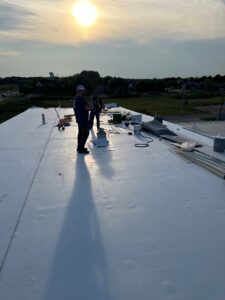When it comes to a commercial roof, choosing the right membrane system can make a significant difference in performance, longevity, and overall value. EPDM, TPO, and PVC are three of the most commonly used single-ply roofing membranes, each with unique characteristics. So how do you know which one is the best fit for your building?

In this post, we’ll break down the differences, pros, and cons of each to help you make an informed decision.
1. EPDM (Ethylene Propylene Diene Monomer)
Overview:
EPDM is a synthetic rubber roofing membrane known for its durability and weather resistance. It’s been a trusted roofing option for decades, especially in colder climates.
Key Benefits:
- Excellent UV resistance
- Long lifespan (20–30 years)
- Highly resistant to ozone and weathering
- Cost-effective for large, low-slope roofs
- Available in black or white
Considerations:
- Black EPDM can absorb heat, potentially increasing cooling costs
- Seams are typically adhered or taped, which can be a weak point over time
- Less puncture-resistant than some alternatives
Best For:
Buildings in cold climates or where UV durability and cost-effectiveness are priorities.
2. TPO (Thermoplastic Polyolefin)
Overview:
TPO is a newer roofing material that has quickly become popular due to its energy efficiency and lower installation costs. It’s a white, reflective membrane that helps reduce heat buildup.
Key Benefits:
- Highly reflective and energy-efficient
- Heat-welded seams for superior strength
- Resistant to mold, tears, and punctures
- Environmentally friendly and recyclable
Considerations:
- Quality can vary between manufacturers
- Shorter track record compared to EPDM and PVC
- Less flexible in extreme cold than EPDM
Best For:
Buildings in warm climates or where energy efficiency and reflectivity are major concerns.
3. PVC (Polyvinyl Chloride)
Overview:
PVC roofing is known for its excellent chemical resistance and strength. It’s commonly used on restaurants and facilities where grease and chemicals are a concern.
Key Benefits:
- Superior chemical and grease resistance
- Long-lasting with high puncture and fire resistance
- Heat-welded seams for durability and leak prevention
- Reflective and energy-efficient
Considerations:
- Generally more expensive than EPDM and TPO
- Can become brittle over time in colder climates
- Plasticizers may leach out over time, affecting flexibility
Best For:
Restaurants, manufacturing plants, or buildings exposed to harsh chemicals and oils.
How to Choose the Right Membrane for Your Building
When selecting the best commercial roof membrane, consider these factors:
- Climate: EPDM excels in colder areas, TPO and PVC perform well in hotter climates.
- Budget: EPDM is typically the most cost-effective upfront; PVC may offer long-term savings in the right conditions.
- Building Use: PVC is ideal for buildings with exposure to chemicals, while TPO is great for energy savings.
- Longevity and Maintenance: Consider the lifespan and how often maintenance is needed.
Need Help Deciding?
Every commercial roof is unique, and what works for one building may not be ideal for another. Our team at 360 Builders Inc specializes in evaluating commercial properties and recommending the best roofing system for your needs, budget, and long-term goals.
Contact us today to schedule a free consultation or roof inspection.
